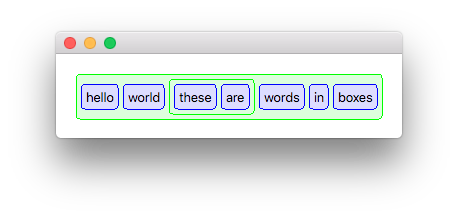|
#!/usr/bin/env python |
|
|
|
# a pyqt script which draws words inside of rounded rectangles. |
|
|
|
# see https://doc.qt.io/qt-5/qpainter.html |
|
# see http://pyqt.sourceforge.net/Docs/PyQt5/api/qpen.html |
|
|
|
import sys |
|
import time |
|
from PyQt5.QtWidgets import * |
|
from PyQt5.QtCore import * |
|
from PyQt5.QtGui import * |
|
|
|
|
|
json_root = ["hello", "world", ["these", "are"], "words", "in", "boxes"] |
|
|
|
|
|
word_rgb = (0,0,255) |
|
array_rgb = (0,255,0) |
|
|
|
|
|
# this function will be called on every paint event. |
|
def on_paint(event, painter): |
|
# fill the canvas with white |
|
painter.fillRect(event.rect(), QBrush(Qt.white)) |
|
# paint the words |
|
(x, y) = (20, 20) |
|
paint_json(json_root, painter, x, y) |
|
|
|
|
|
# recursively paint a json structure, starting at (x,y). |
|
# returns the (width, height) used to paint the word. |
|
def paint_json(js, painter, x, y, pad=5): |
|
if isinstance(js, list): |
|
# first, paint the container box |
|
(w, h) = size_of_json(js, painter, pad) |
|
paint_box(painter, x, y, w, h, array_rgb) |
|
# now paint the elements inside of the box |
|
for j in js: |
|
x += pad |
|
(jw, jh) = size_of_json(j, painter, pad) |
|
paint_json(j, painter, x, y + ((h-jh)/2), pad) |
|
x += jw |
|
return (w, h) |
|
else: |
|
return paint_word_in_box("%s" % js, painter, x, y, word_rgb, pad) |
|
|
|
|
|
# paint a word inside of a box, starting at (x, y). |
|
# returns the (width, height) used to paint the word. |
|
def paint_word_in_box(text, painter, x, y, rgb, pad=5): |
|
# calculate the size of the text |
|
text_bounds = QFontMetrics(painter.font()).boundingRect(text) |
|
w = pad + text_bounds.width() + pad |
|
h = pad + text_bounds.height() + pad |
|
paint_box(painter, x, y, w, h, rgb) |
|
# configure the text stroke |
|
pen = QPen() # defaults to black |
|
painter.setPen(pen) |
|
# draw the text |
|
text_top_fudge = -2 # qt text seems to have extra padding on top. |
|
baseline = y + text_bounds.height() + pad + text_top_fudge |
|
painter.drawText( |
|
pad + x, |
|
baseline, |
|
text |
|
) |
|
return (w, h) |
|
|
|
|
|
# paint a box (with a border stroke and rounded corners) |
|
def paint_box(painter, x, y, w, h, rgb): |
|
corner_radius = 4 |
|
# configure the box stroke |
|
pen = QPen() |
|
(r,g,b) = rgb |
|
pen.setColor(QColor(r,g,b,255)) |
|
pen.setWidth(1) |
|
painter.setPen(pen) |
|
# configure the box fill |
|
(r,g,b) = lighter_rgb(rgb) |
|
painter.setBrush(QBrush(QColor(r,g,b,255))) |
|
# draw the box |
|
# note: the rounded corners come out a bit odd. |
|
# see https://stackoverflow.com/questions/6507511/qt-round-rectangle-why-corners-are-different |
|
painter.drawRoundedRect( |
|
x, y, w, h, |
|
corner_radius, |
|
corner_radius |
|
) |
|
|
|
|
|
# return a lighter version of a color |
|
def lighter_rgb(rgb): |
|
(r,g,b) = rgb |
|
return ( |
|
min(255, int(r + ((255-r)/1.15))), |
|
min(255, int(g + ((255-g)/1.15))), |
|
min(255, int(b + ((255-b)/1.15))), |
|
) |
|
|
|
|
|
# calculate the bounding box size of a json structure |
|
def size_of_json(js, painter, pad=5): |
|
if isinstance(js, list): |
|
total_w = pad |
|
total_h = 0 |
|
for j in js: |
|
(w, h) = size_of_json(j, painter, pad) |
|
total_w += (w + pad) |
|
total_h = max(total_h, h) |
|
return (total_w, pad + total_h + pad) |
|
else: |
|
return size_of_word_in_box("%s" % js, painter, pad) |
|
|
|
|
|
# calculate the bounding box size of a word in a box |
|
def size_of_word_in_box(text, painter, pad=5): |
|
text_bounds = QFontMetrics(painter.font()).boundingRect(text) |
|
w = pad + text_bounds.width() + pad |
|
h = pad + text_bounds.height() + pad |
|
return (w, h) |
|
|
|
|
|
# a widget which paints words inside of boxes |
|
class WordPainter(QWidget): |
|
def __init__(self, on_paint_fn): |
|
QWidget.__init__(self) |
|
self.on_paint_fn = on_paint_fn |
|
|
|
# this gets called every time the widget needs to repaint (e.g. window resize) |
|
def paintEvent(self, event): |
|
then = time.time() |
|
painter = QPainter() |
|
painter.begin(self) |
|
self.on_paint_fn(event, painter) |
|
painter.end() |
|
now = time.time() |
|
elapsed = now - then |
|
print "elapsed: %s" % elapsed |
|
print "fps: %s" % (1.0/elapsed) |
|
|
|
|
|
if __name__ == "__main__": |
|
app = QApplication(sys.argv) |
|
window = WordPainter(on_paint) |
|
window.show() |
|
sys.exit(app.exec_()) |
